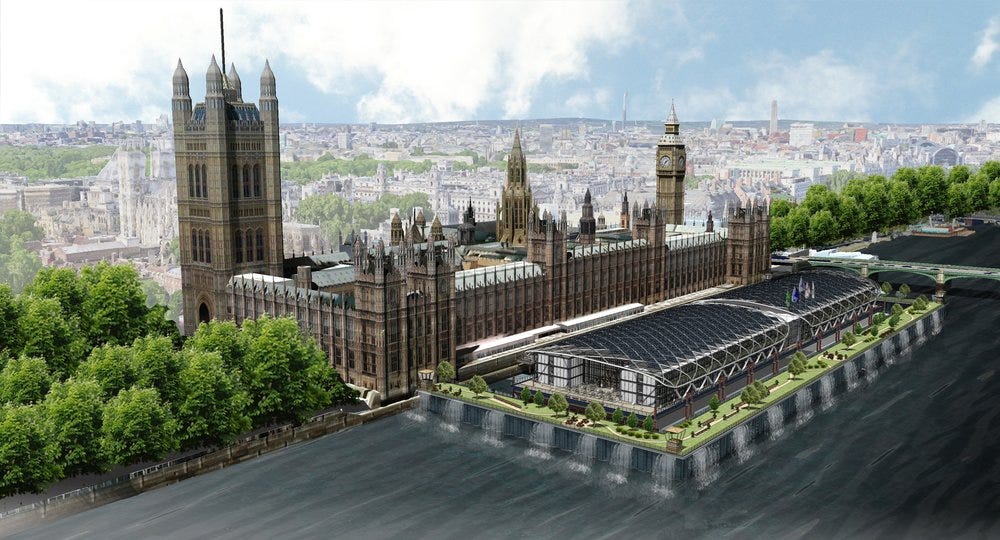Written by Stella Tsantekidou for the Greater London Project.
If you’ve ever been young and obsessed with politics, you will know how I felt when I first walked into Parliament. Like me, many young people got their first in the door of British politics working in one of the many historic buildings around the parliamentary estate .
But the centuries of history that make Westminster Palace so awe-inspiring are starting to take their toll. Today, much of the estate is prone to flooding, new discoveries of asbestos, and electrical fires. Many offices are on borrowed time, and will have to be closed.
It’s understandable that MPs in previous Parliaments refused to “decant” from the building for refurbishments. After all, the average tenure of an MP is 8 years, while the restoration of Parliament is estimated to take 15-20 years if they all relocate. Many parliamentarians would go their whole careers without stepping foot in the mother of all parliaments. It’s a long time to go without the famous jerk chicken.
But without relocation, the timeline for refurbishment stretches to 50-70 years, and the costs skyrocket. But that’s the price we are all paying for a Parliament which can’t face change.
It’s become a truism to complain about Britain’s inability to build fast enough to meet its needs. The delay in restoring our Parliament is our ultimate test. Perhaps there, the approach we take can set the tone for the innovation and industriousness we want to see the government apply to rebuilding Britain at large.
Daniel K. Ludwig, a German-American industrialist active after World War II, foresaw that the increasing popularity of newspapers would drive up the cost of paper. However, producing paper posed challenges: growing trees required time and space, and finding suitable land, climate, and labour in the U.S. was difficult. At the same time, constructing pulp mills in less developed countries was a slow and complex process. Instead of importing wood, Ludwig devised a novel solution: placing a pulp mill on a barge and moving it to where the wood supply was abundant.
The concept of transporting entire built structures on barges, rather than just raw materials, left a lasting impression on Norwegian engineer Svein Kjelstrup Olsen. Living in Battersea by the Thames, Svein recalled Ludwig’s innovation while watching boats pass. In 2018, he read Parliament’s first restoration report, which had briefly considered but ultimately dismissed the idea of a floating structure on the Thames, arguing that it would require the entire river breadth.
Accustomed to spatial problem-solving, Svein questioned this claim. He obtained a floor plan for Parliament and calculated that both the Houses and the central lobby could fit within the Port of London Authority’s designated secure zone- an area already restricted from boat crossings and moorings.

The concept for a waterside Parliament presents numerous advantages. It is the cheapest, requires limited capital expenditure and spares taxpayers any upfront costs, providing a reassuring demonstration of financial prudence. The building modules needed are constructed in Hull and Littlehampton, and then transported via barges to be assembled on site. It is the most environmentally sustainable option, with photovoltaic panels on the roof creating a carbon-neutral facility that addresses the other uniquely British building obstacle of inadequate grid energy. It is also the kindest option for staff members, who can all relocate to the new structure without going far.
When I first met Svein to discuss the project, I wanted to know why this was so unique, and not used more widely for temporary construction. With practised Nordic stoicism, he explained that the technology already exists, the expertise is readily available, the materials needed have been sourced, and the companies willing to deliver the structures have already been engaged.
Svein showed me the state-of-the-art facilities' beautiful, light, and airy designs. They can be constructed within 24 months of planning approval and can save approximately £1 billion by allowing the full vacation of the deteriorating Palace of Westminster. The other options to decant parliamentarians into Richmond House or the QEII conference centre are slower and costlier. They would house the Commons and the Lords separately, which makes the security of both less practical, along with the hosting of grand occasions like the state opening of Parliament.
Waterside is an opportunity to fast-track the renovation of Parliament to protect our heritage, and to do so without wasting money at a time when the state needs it more than ever. Privately leased, once it is no longer needed the barge units can be repurposed into affordable housing (Svein estimates 160-270 units depending on size),
Our physical environment profoundly impacts our thoughts and actions. The last major additions to London’s landscape are quickly receding into the past – the Shard in 2012 and the London Eye in 2000. If, as Paul Graham said, Florence inspired the genius of Leonardo da Vinci and Michelangelo, and Silicon Valley shaped visionaries like Steve Jobs and Mark Zuckerberg, what does the lack of ingenuity about restoring Parliament do to affect the confidence of our leaders that they can rebuild Britain?
Londoners are tired of the visible decay in our infrastructure. The new class of parliamentarians have a four-year window to prove they are serious about building. I say they start with their own house, and fix the roof while the sun is shining (or at least before the rain gets worse).






How would Buckingham Palace work as an alternative? Would there be space to work their - I imagine there would be, and His Majesty seems to prefer his country homes or Clarence House when in London. Would that not be cheaper and less impractical?